Return to the BIRMINGHAM SMALL ARMS Co. HISTORY MAIN PAGE
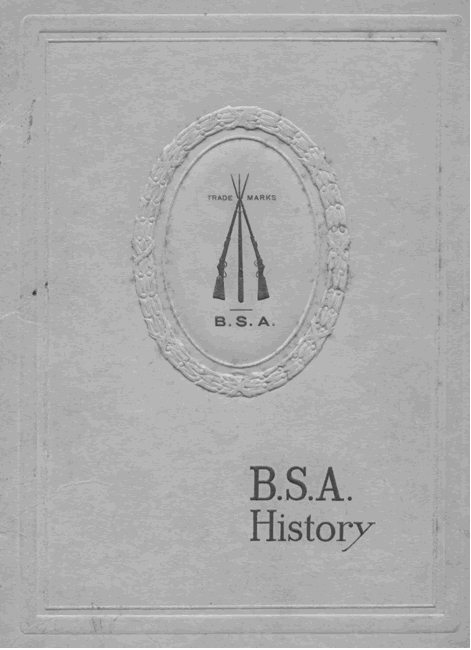
Please be aware that some specialist imagery may take time to load.
This site is designed for dedicated researchers on desktop or tablet, not ideal for mobile browsing.
Return to the BIRMINGHAM SMALL ARMS Co. HISTORY MAIN PAGE

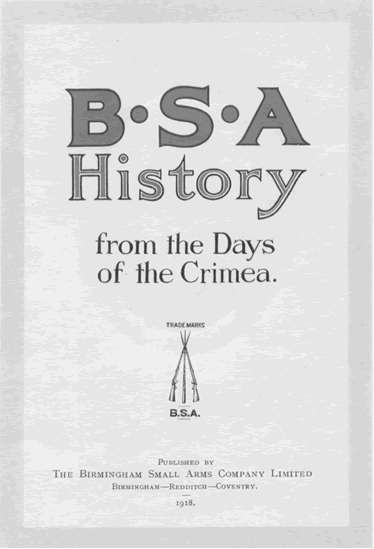
THE vast assembly of buildings and workshops, full of busy workers and humming with the energy of thousands of wheels, all engaged on the production of the various manufactures for which The Birmingham Small Arms Company Limited is world-famous, naturally provokes the question how so great an organization had its origin. A brief resume of the rise and progress of the B.S.A. Company will therefore doubtless be of interest, not only to those familiar with the letters " B.S.A." and what they stand for, but also to everyone interested (and who is not ?) in the question of our national munition supplies.
Founded at a time of national crisis, The Birmingham Small Arms Company
is an example of how history repeats itself, as it was  directly
owing to a shortage of munitions at the outbreak of the Crimean War (I854-56)
that the Company had its inception. Those were days long before a Ministry
of Munitions was thought of, and the situation being extremely serious the
Government called on sixteen firms of small arms manufacturers in Birmingham
to furnish a supply of arms. At this period the rifles were of the muzzle-loading
pattern, and were entirely hand-made, but it was not long before the Government
commenced the manufacture of rifles by machinery at the Enfield Works. This
was shortly followed in 1861 by the members of the Birmingham small arms
trade consolidating themselves under the title of The Birmingham Small Arms
Company. The munition resources of Birmingham being thus co-ordinated, a
factory was erected at Small Heath for the manufacture of small arms by
machinery.
directly
owing to a shortage of munitions at the outbreak of the Crimean War (I854-56)
that the Company had its inception. Those were days long before a Ministry
of Munitions was thought of, and the situation being extremely serious the
Government called on sixteen firms of small arms manufacturers in Birmingham
to furnish a supply of arms. At this period the rifles were of the muzzle-loading
pattern, and were entirely hand-made, but it was not long before the Government
commenced the manufacture of rifles by machinery at the Enfield Works. This
was shortly followed in 1861 by the members of the Birmingham small arms
trade consolidating themselves under the title of The Birmingham Small Arms
Company. The munition resources of Birmingham being thus co-ordinated, a
factory was erected at Small Heath for the manufacture of small arms by
machinery.
OPENING OF THE B.S.A. FACTORY.
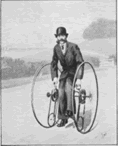 This
was opened in 1862, and though considered at the time quite an imposing
edifice, the original B.S.A. factory is now a very small portion of the
B.S.A. Works. Extensions have had to be constantly made until the present
day works, at Small Heath alone, contain a shop floor space of over 26 acres.
Further developments took place in 1873 when the manufacture of ammunition
was added to that of rifles. For this purpose certain metal works at Adderley
Park
This
was opened in 1862, and though considered at the time quite an imposing
edifice, the original B.S.A. factory is now a very small portion of the
B.S.A. Works. Extensions have had to be constantly made until the present
day works, at Small Heath alone, contain a shop floor space of over 26 acres.
Further developments took place in 1873 when the manufacture of ammunition
was added to that of rifles. For this purpose certain metal works at Adderley
Park
were acquired, and the Company 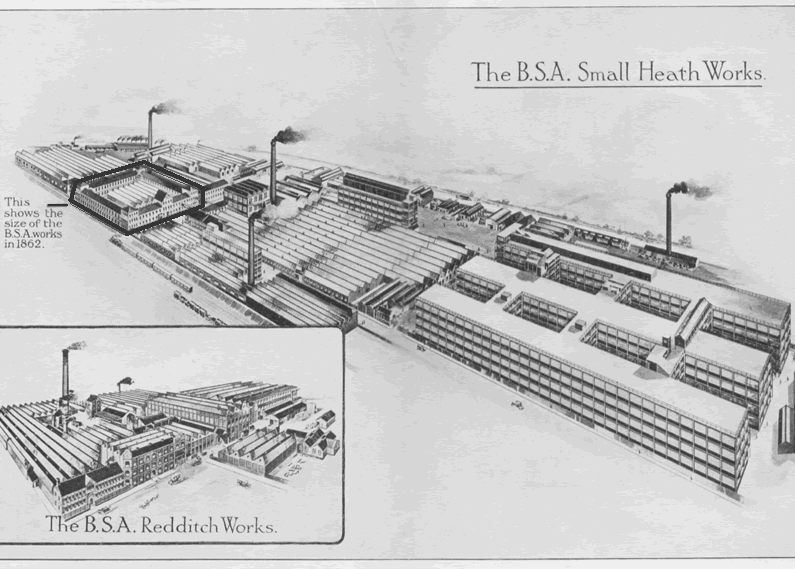 became
known as The Birmingham Small Arms and Metal Company.
became
known as The Birmingham Small Arms and Metal Company.
Government orders absorbed nearly all the energies of the Company, the first
order from the British Government being for Enfield Muzzle-loading Rifles-after
which in succession were manufactured the Snider Rifle (the first breech-loading
rifle used by this country), and subsequently the Martini-Henry Rifle, and
(in 1888) the Lee-Metford Bolt-action Magazine Rifle.
The Company has thus been very intimately associated with the evolution
of the British Service Rifle-from muzzle-loader to single shot breech-loader,
and thence to the latest pattern Lee-Enfield charger loading magazine short
pattern rifle, which our armies are using. Although its action is not quite
so strong as that of some other rifles, yet it possesses several advantages,
and has proved to be by far the most effective rifle used in the war. Besides
being extremely rapid and accurate, its build suits trench warfare better
than any other.
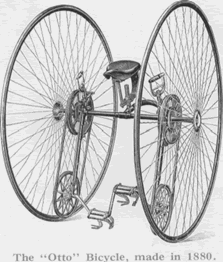
Orders for Rifles and Ammunition for the British, Russian, Turkish, Dutch
and Portuguese Governments kept the Company fully occupied until 1880. In
that year, however, when Government orders for rifles and ammunition were
not sufficient to keep the plant and staff fully employed, the Company turned
its attention to cycle manufacture, for which the B.S.A. works were particularly
suitable.
With the widened sphere of activities the B.S.A. reputation for fine workmanship
and finish rapidly advanced, and the names of many of the bicycles and tricycles
produced are still remembered as representing some of the finest examples
of cycle construction in their day.
EARLY EXPERIMENTS WITH BICYCLES AND TRICYCLES.
The first bicycle manufactured in any quantity by the Birmingham Small Arms
Company was the " Otto " Safety Bicycle, an interesting illustration
of which is given. It is curious to note that this early type of bicycle
had its wheels side-by-side, instead of one wheel behind the other as later
became the standard, and it was no easy matter to effect the satisfactory
balance which was necessary before comfortable riding could be enjoyed.  It is
recorded that when the designer was negotiating with the Birmingham Small
Arms and Metal Company for the manufacture of the " Otto," being
anxious to prove that his machine was correct in design and principle, he
offered to give a demonstration by riding down a winding staircase of about
thirty steps. This performance was successfully accomplished, and evidently
satisfied the management, as the manufacture of the machine was then taken
over, and continued during the years 1880 to 1883.
It is
recorded that when the designer was negotiating with the Birmingham Small
Arms and Metal Company for the manufacture of the " Otto," being
anxious to prove that his machine was correct in design and principle, he
offered to give a demonstration by riding down a winding staircase of about
thirty steps. This performance was successfully accomplished, and evidently
satisfied the management, as the manufacture of the machine was then taken
over, and continued during the years 1880 to 1883.
It was at this period the Company made the "Alpha" Ordinary Bicycle
; also the " Beta " and " Delta " Tricycles. In the
meantime, in 1881, the manufacture of the "Omnicycle" Tricycle,
designed by Mr. T. Butler, was taken up by the Company. This machine was
a rear-driven three-tracker, propelled by a reciprocal motion. Another rear-driven
three-tracker, the " Devon" Tricycle, was manufactured in the
following year for Messrs. Maynard, Harrison & Company. This machine
possessed the advantage of a swing frame, which enabled the rider to use
the whole of his strength whilst in an upright position, and was equipped
with a "ground brake".
In 1882, the Company made yet another three-tracker tricycle
with rear drive, known as "The Rucker," for Messrs. Rucker &
Company, of London.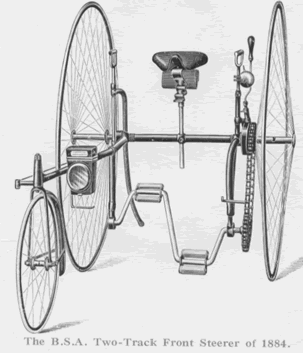
Quite a novelty was introduced in the shape of the B.S.A. Compressible Tricycle,
which the Company designed and manufactured in 1883. This was a three-track
single driving machine, and by an ingenious adjustable lug the frame could
be made to slide, so that the width of the machine was considerably reduced,
enabling it to be wheeled through an ordinary doorway. This type, however,
did not find much favour with the riding public of that day, and was before
long withdrawn.
It was followed in 1884 by the B.S.A. Front Steerer, a
three-track tricycle with loop frame, and the B.S.A. Two-track Front Steerer,
both of which we are able to illustrate. The same year also witnessed the
introduction of the first bicycle which could be really regarded as the
forerunner of the present safety machine, and early in the following year
this safety model was put upon the market by the Company. An illustration
of this interesting bicycle is given.
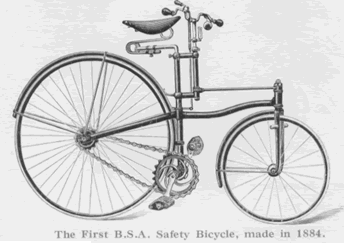
The output of B.S.A. safety bicycles and tricycles steadily increased during
the next three years, but in 1887 the Government demand for rifles and ammunition
rendered it incumbent upon the Company to temporarily discontinue the manufacture
of bicycles and tricycles, and for six years nothing was done in this direction
beyond the production of a limited quantity of Kelsey's Duplex Safety Bicycle
Crank Axle Bearings. During those six years the Company manufactured not
only rifles, but also large numbers of six-pounder and three-pounder cartridges
for quick-firing guns.
CYCLE MANUFACTURE RECOMMENCED.
When the Government demand for rifles and ammunition somewhat declined,
the Company once more was enabled to take up the manufacture of bicycles,
and early in 1893 commenced the manufacture of safety bicycle hubs, examples
of which were exhibited at the Crystal Palace Show that same year. 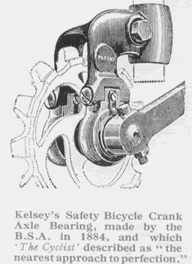 A
little later the Company intro¬duced brackets, cranks, steering heads,
seat lugs, chain wheels, fork and stay ends, and pedals, and at the Crystal
Palace Show of 1894 exhibited a complete set of B.S.A. Cycle Fittings. From
1895 improvement followed im¬provement in the design of B.S.A. bicycle
fittings ; a narrower chain line was introduced by the B.S.A. Company, and
at the same time the length of B.S.A. crank was increased from 6in. to 6½in.,
both of which developments enabled the rider to apply greater power and
attain higher speeds.
A
little later the Company intro¬duced brackets, cranks, steering heads,
seat lugs, chain wheels, fork and stay ends, and pedals, and at the Crystal
Palace Show of 1894 exhibited a complete set of B.S.A. Cycle Fittings. From
1895 improvement followed im¬provement in the design of B.S.A. bicycle
fittings ; a narrower chain line was introduced by the B.S.A. Company, and
at the same time the length of B.S.A. crank was increased from 6in. to 6½in.,
both of which developments enabled the rider to apply greater power and
attain higher speeds.
In 1896 the Small Heath Works were largely extended to enable the Company
to better deal with the rapidly growing demand for B.S.A. cycle components,
for though B.S.A. parts had only been on the market a very short time, the
Company had achieved a great reputation for good and accurate work in cycle
manufacture.
The Inspection Department for cycle fittings had been organised on the system
as used in the manufacture of military small arms, and the careful viewing
and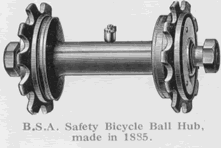 testing inaugurated in those early days, and still retained, has been responsible
to a great degree in keeping up the very high standards of quality and interchangeability
which have made B.S.A. manufactures world-famous.
testing inaugurated in those early days, and still retained, has been responsible
to a great degree in keeping up the very high standards of quality and interchangeability
which have made B.S.A. manufactures world-famous.
In 1896 the entire business of manufacturing ammunition, together with the
property used for this purpose at Adderley Park and Streetly, was disposed
of to the Directors of the Nobel-Dynamite Trust Limited, who formed a new
company to take over the works in question, under the title of The Birmingham
Metal and Munitions Company Limited. Henceforward the Small Arms Com¬pany,
which for the previous twenty-three years had been known as The Birmingham
Small Arms and Metal Company, reverted to its earlier name, which it has
held ever since, namely, The Birmingham Small Arms Company Limited.
IMPROVEMENTS AND ULTIMATE STANDARDIZATION.
Further improvements in 1896-7 included the making of B.S.A. Block Chains,
1/4in. in width, for the manufacture of which a special plant, embodying
the latest developments in cycle chain making machinery, had been added
to the works. This season also saw the listing for the first time of B.S.A.
Frames for ladies' and gents' machines. B.S.A. Handlebars were also manufactured
at this time, and the famous B.S.A. Spanners, designed to fit all sizes
of B.S.A. nuts, which had been carefully standardized, were first produced.
The following year standardization was more
fully recognised as being expedient and desirable, and the catalogue for
1898 makes mention of the fact that the standard patterns of the previous
year would remain practically the same, as no alterations were deemed necessary.
A plant for the production of brake-work was installed during 1898, and
the B.S.A. Plunger Front Brake was first listed in that year ; the brake-shoe
being fitted with patent rubber brushes or solid rubber blocks as desired.
A malleable iron foundry was added at this time, and also a plant for making
steel balls.
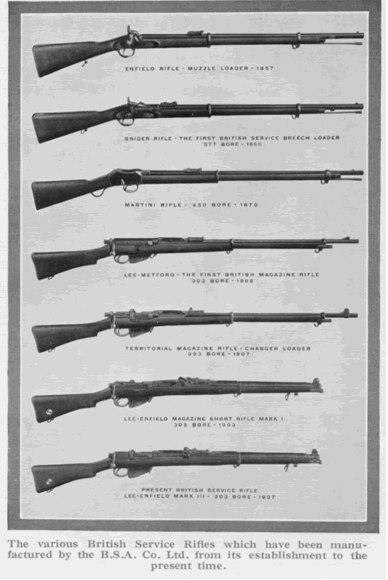
In 1899, although as previously stated the general design of bicycle frame had become practically standard, and the method of drive by chain to the back wheel was the invariable practice, numerous improvements in detail were made with a view to securing ease of propulsion and the transmission of the maximum amount of power from the rider to the back wheel. To this end a new chain wheel was produced by the B.S.A. Company, with more than twenty teeth-which number had hitherto been the maximum ; wheels for ½ in. pitch roller chains were made 3/16 in. wide roller chains of the same size were produced, and at the same time the chain wheel was made detachable from the crank. To ensure greater strength and longer service, the side plates of rat-trap pedals were also fitted with stays. The famous B.S.A. Cam Chain Adjustment was also introduced in the same year.
FEATURES THAT SEALED THE POPULARITY OF THE BICYCLE
The following year, 1900, saw the introduction of the B.S.A. Free Wheel
Clutch and the B.S.A. Back-pedalling Rim Brake, both of which achieved instant
popularity. It is interesting to recall that the B.S.A. design for 1900
provided a somewhat longer wheel base on account of the demand for long
cranks. A Front Pull-up Rim Brake was
designed in 1901, and B.S.A. Mudguards and Stays were first made in the
same year. Fittings supplied by the B.S.A. Company in 1902 included sets
for path racer, light roadster, full roadster, and ladies' machines. This
year also saw the introduction of the standard pattern Spring Frame which
was supplied to the trade complete. The B.S.A. Spring Frame was one of the
most successful ever put on the market, and numbers are still in use after
years of service.
Digressing a moment, it is necessary here to mention that a yet further
activity of the B.S.A. Company had been gradually developing since 1890,
in the shape of the manufacture of Sporting and Target Rifles, which had
made a great name for themselves in the hands of big-game hunters and sportsmen
generally.
The Boer War gave an impetus to the sport and practice of rifle shooting,
and upon its conclusion in 1902 there began a notable increase in the number
of rifle clubs in Great Britain. To cater for the new public demand the B.S.A. Company promptly designed a special Service  Pattern
Rifle, which was used with Morris Tubes ; this was followed by the Service
Rifle fitted with a barrel made specially for the '22 Rim Fire Cartridge,
and as a result of the readiness of the B.S.A. Company to handle the new
demand, the private trade in B.S.A. Rifles was put on a new and much wider
basis. Further developments included the manufacture of a rifle designed
by the War Department specially for short range practice, which was known
as the War Office Miniature Rifle.
Pattern
Rifle, which was used with Morris Tubes ; this was followed by the Service
Rifle fitted with a barrel made specially for the '22 Rim Fire Cartridge,
and as a result of the readiness of the B.S.A. Company to handle the new
demand, the private trade in B.S.A. Rifles was put on a new and much wider
basis. Further developments included the manufacture of a rifle designed
by the War Department specially for short range practice, which was known
as the War Office Miniature Rifle.
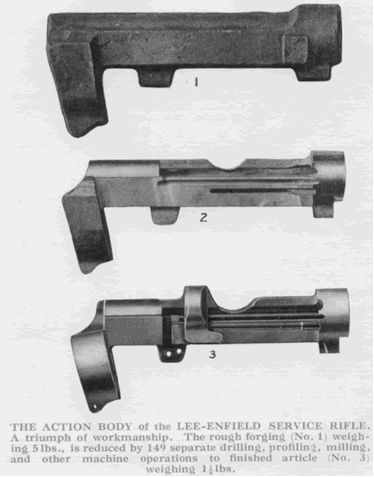 This
type has been largely used all over the world in musketry training.
This
type has been largely used all over the world in musketry training.

Reverting to cycle matters, the B.S.A. Free Wheel Hub, made in 1902, was
a combined hub and free wheel clutch so arranged that wheels could be built
and the spokes easily inserted or removed without dismounting any portion
of it. The B.S.A. Free Wheels, which fitted all B.S.A. Hubs, proved, however,
the more popular, and the manufacture of the combined hub and free wheel
was discontinued. This year saw the introduction of the practice of slotting
B.S.A. Fork Ends to obviate the necessity for springing the forks when removing
a wheel. A new set of fittings for path racer machines was also introduced,
featuring a sloping top bar, light in weight, and built for speed. It is
noteworthy that during the following years numerous famous racing men made
some of their finest records on these machines.
On the race track both J. S. Benyon and A. E. Wills scored many successes
on B.S.A. Bicycles. The first-named was probably the best short distance
rider of his day, while the latter rider achieved some remarkable successes
in long-distance motor-paced races on the Continent.
Amongst road racing cyclists two representative B.S.A. riders were T. Peck
and C. Moss. T. Peck was the first cyclist to ride from Land's End to John
o' Groat's, 8371 miles, under three days. Many extraordinary rides were
accomplished by C. Moss, amongst them being the winning outright of the
Bath Road 100 miles Cup, for fastest time three consecutive years, on the
third occasion his record being well under 5 hours.
THE WAR OFFICE ADOPTS B.S.A. FITTING
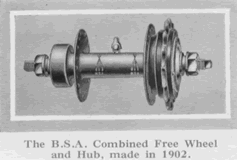 The
year 1902, was an eventful one for the B.S.A. Company, for in that year
the War Office adopted B.S.A. Fittings for Military Bicycles, and the majority
of bicycles used by the War
The
year 1902, was an eventful one for the B.S.A. Company, for in that year
the War Office adopted B.S.A. Fittings for Military Bicycles, and the majority
of bicycles used by the War 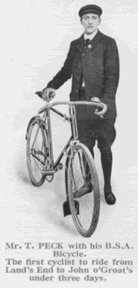 Office
from that time onward were built of B.S.A. Fittings. No higher compliment
could be paid to the B.S.A. Company than this adoption by the War Office
of the productions of the Cycle Department, after their many years' experience
of the absolute reliability of the firm's rifles.
Office
from that time onward were built of B.S.A. Fittings. No higher compliment
could be paid to the B.S.A. Company than this adoption by the War Office
of the productions of the Cycle Department, after their many years' experience
of the absolute reliability of the firm's rifles.
In 1904 the B.S.A. Company manufactured a Rear Rim Brake with Pull-up Lever.
Up till then the use of rim brakes had been confined to the front wheel.
B.S.A. MOTOR BICYCLES
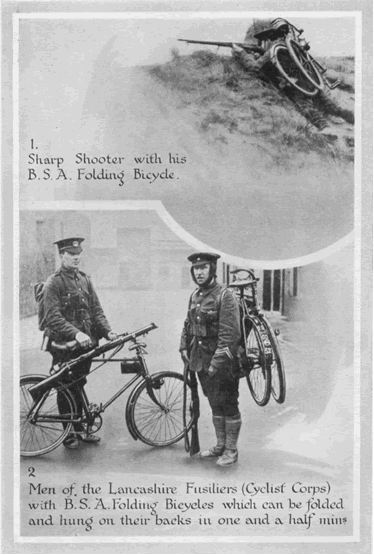
With the rise of the motor cycle trade in 1902 the B.S.A. Company had marketed
special fittings and frames suitable for use with low power motor engines.
Then in 1905, a further development in the design of B.S.A. Motor Bicycle
Frames took place, and the Spring Frame next introduced marked a great advance
towards comfortable riding. 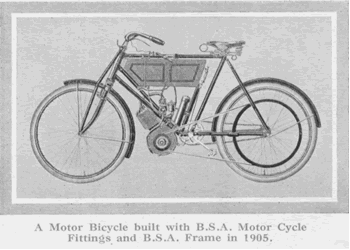
This frame was designed to suit inclined engines from 2 h.p. to a 4 h.p. Sets of Motor Bicycle Fittings were also supplied for vertical engines up to 3 ½ h.p. or inclined engines up to 2¾ h.p.
MAKING OF AIR RIFLES COMMENCED.
Before passing the year 1905, it is necessary to mention
that the B.S.A. Company in that year commenced the manufacture of their
famous Air Rifle, which has since achieved such immense popularity, many
even being imported into the U.S.A. - the stronghold of rifle manufacture-despite
a 35% ad val. duty. Another phenomenally successful rifle introduced a little
later was the B.S.A. Martini Target Rifle.
Coming now to more recent times, it will probably be within the memory of
most, that the year 1906 saw the introduction of the B.S.A. Coaster Hub
and the B.S.A. Change-speed Hub.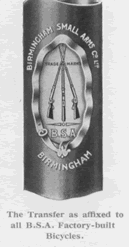
The following year witnessed an important development in the history of
the B.S.A. Company, an amalgamation
 with
the Eadie Manufacturing Company, of Redditch, being then completed, which
enabled the Birmingham Small Arms Company Limited to greatly increase its
capacity for the production of Cycle Components and Cycle Specialities.
Chief among these came the Eadie Coaster Hub, Eadie Two-Speed Coaster Hub,
Eadie Two¬Speed Hub, and the Hyde Free Wheel, These fitments, together
with the B.S.A. Three-speed Hub, B.S.A. Chains, and B.S.A. Free Wheels,
gave the Company by far the largest range of coasters, variable gears, free
wheels, etc., possessed by any firm or company.
with
the Eadie Manufacturing Company, of Redditch, being then completed, which
enabled the Birmingham Small Arms Company Limited to greatly increase its
capacity for the production of Cycle Components and Cycle Specialities.
Chief among these came the Eadie Coaster Hub, Eadie Two-Speed Coaster Hub,
Eadie Two¬Speed Hub, and the Hyde Free Wheel, These fitments, together
with the B.S.A. Three-speed Hub, B.S.A. Chains, and B.S.A. Free Wheels,
gave the Company by far the largest range of coasters, variable gears, free
wheels, etc., possessed by any firm or company.
THE COMPLETE B.S.A. BICYCLE.
In 1908, to meet the somewhat altered conditions of trade, it was considered
advisable to manufacture complete
B.S.A. Bicycles in the B.S.A. Factories. In announcing the new policy at
the Annual Meeting the Chairman stated " that the Company had decided
to widen the policy in regard to the manufacture of complete bicycles. Hitherto
only cycle agents were supplied with complete machines bearing an agent's
transfer. In view of the somewhat altered conditions of the trade, it was
considered advisable to manufacture a complete B.S.A.
Bicycle, under the most rigid inspection, with the world-famed B.S.A. Fittings.
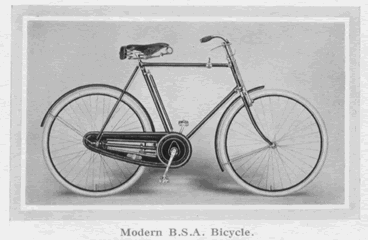
There would be one grade of machine-the
highest possible quality only. The machine so offered to the public would
be listed at a higher price than that at which bicycles built with B.S.A.
Fittings had been sold by local agents and makers. The management believed
that this would not only create a greater demand for B.S.A. productions,
but that it would have a steadying effect on the cycle trade generally.
Such a policy must tend to place the B.S.A. Fittings on a higher plane,
and to a great extent prevent bicycles built with B.S.A. Fittings being
sold at ridiculously low prices, showing little or no margin of profit to
the retailer." Although the new policy was severely criticised, events
have proved that it not only helped the trade generally, but was much appreciated
by the public. The complete B.S.A. Bicycle produced at The B.S.A. Company's
works bears a special transfer (as illustrated above).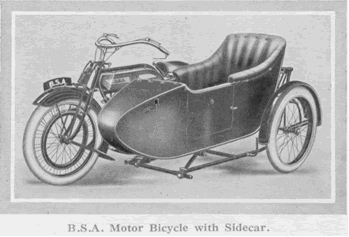
Following on the most favourable reception accorded to complete B.S.A. Bicycles,
in 1909 complete Motor Bicycles were introduced, and to-day B.S.A. Motor
Bicycles, both as solo mounts and for side-car work, have made a name for
themselves throughout the world.
In 1914 the Gradual Payment System was inaugurated for the convenience of
those who wished to purchase B.S.A. Bicycles and Motor Bicycles out of income.
This system has proved extremely popular.
AN IMPORTANT AMALGAMATION
Another important step in B.S.A. history was that taken in 1910, when an
amalgamation was effected with The Daimler Company Limited, of Coventry.
The Motor Vehicles produced by this Company are famous the world over.
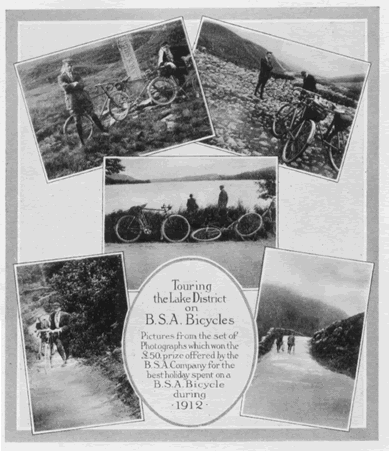
On July 23rd, 1915, His Majesty King George V. honoured the B.S.A. Company
with a visit. Having inspected the Guard of Honour drawn up at the gates,
His Majesty proceeded to make a tour of the works, where he was greatly
interested in the various operations that were being carried through, particularly
in the firing of the Lewis Automatic Gun.
After viewing the new rifle shops His Majesty walked through the Cycle Factory,
where he was shown the work on military bicycles and machine gun parts,
and then passed through the Hardening Shop, Smithy, Barrel Mill and Stocking
Shop. The different processes of manufacture were explained, and in all
of them the King evinced the keenest interest, picking up for closer inspection
several finished and unfinished parts displayed on the benches.
The King was enthusiastically welcomed by the work-people at various points
during his progress through the factory. Before he departed His Majesty
signed the Visitors' Book, and expressed his satisfaction at all he had
seen.
His Majesty left by the main gates of the factory, and slowly drove through
the cheering crowd of employees.

Reproduction of the King's Signature as it appears in the B.S.A. Visitors'
Book.
THE ROYAL VISIT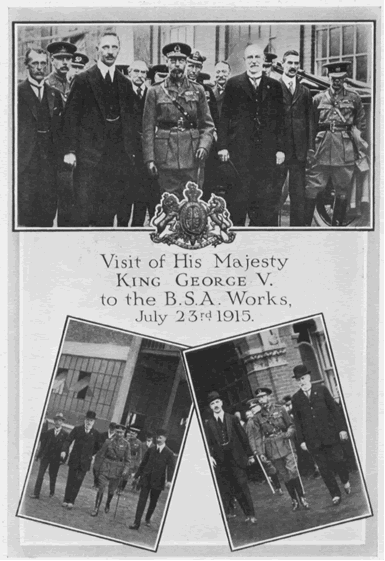
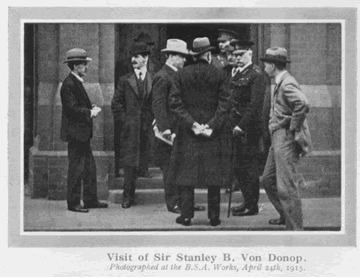 Amongst
other distinguished visitors who have inspected the B.S.A. Works from time
to time are Sir Stanley B.Von Donop,K.C.B., who was then Master of Ordnance
; His Highness the Crown Prince of Uganda; Representatives of DomiinionParliaments
attending the Imperial Conference ; Members of the Serbian. Mission, etc.
Amongst
other distinguished visitors who have inspected the B.S.A. Works from time
to time are Sir Stanley B.Von Donop,K.C.B., who was then Master of Ordnance
; His Highness the Crown Prince of Uganda; Representatives of DomiinionParliaments
attending the Imperial Conference ; Members of the Serbian. Mission, etc.
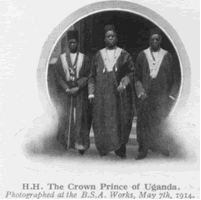 An interesting occasion was that of a tour of the works made by a contingent
of Indian and Colonial troops visiting this country for the Coronation of
King George V. The men were greatly impressed by the magnitude of the factory.
After luncheon a fleet of Daimler motor cars took the party to Warwick Castle,
where they were entertained to tea by the Countess of Warwick.
An interesting occasion was that of a tour of the works made by a contingent
of Indian and Colonial troops visiting this country for the Coronation of
King George V. The men were greatly impressed by the magnitude of the factory.
After luncheon a fleet of Daimler motor cars took the party to Warwick Castle,
where they were entertained to tea by the Countess of Warwick.
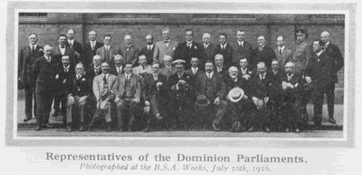
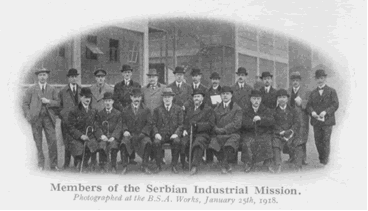
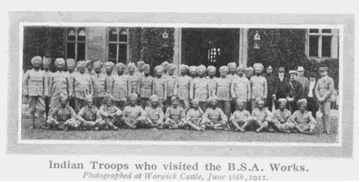
THE GREAT WAR
Fittingly enough this history, which commenced with the Crimean War, brings us to the days of the Great War, when once again the national demand is "Munitions and still more munitions," but in far greater quantities than ever conceived possible in 1855. Only with the passing of time will it be possible to obtain a full perspective of all the events now taking place. Suffice it to say that with the declaration of war, in August 1914, the B.S.A. Factories entered on a period of tremendous activity.
 Day
and night, week-days and Sundays, without cessation, munitions were produced
in quantities which even surprised the management. Being immediately forthcoming,
the value of this aid can scarcely be overestimated ; for it materially
assisted our army to "keep up its wicket" in the early days of
the War against an enemy of unprecedented strength and organization.
Day
and night, week-days and Sundays, without cessation, munitions were produced
in quantities which even surprised the management. Being immediately forthcoming,
the value of this aid can scarcely be overestimated ; for it materially
assisted our army to "keep up its wicket" in the early days of
the War against an enemy of unprecedented strength and organization.
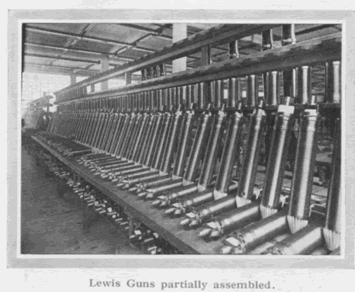 Perhaps
the most notable of B.S.A. Products for military purposes is the Lewis Automatic
Machine Gun. Fortunately the B.S.A. Company previous to the War had made
arrangements for manufacturing this weapon, and it was soon possible to
supply large numbers for use on aeroplanes, and for other sections of our
army. The efficiency and deadliness of the Lewis gun have achieved world-wide
fame ; its wonderful qualities are enthusiastically recognised throughout
the British and Allied Armies.
Perhaps
the most notable of B.S.A. Products for military purposes is the Lewis Automatic
Machine Gun. Fortunately the B.S.A. Company previous to the War had made
arrangements for manufacturing this weapon, and it was soon possible to
supply large numbers for use on aeroplanes, and for other sections of our
army. The efficiency and deadliness of the Lewis gun have achieved world-wide
fame ; its wonderful qualities are enthusiastically recognised throughout
the British and Allied Armies.
Simultaneously with this enormous acceleration of B.S.A. production, the
Company, realising that the struggle would be a long and difficult one,
with far-seeing prudence prepared their plans accordingly, and it was not
long before a series of huge buildings, erected by the most modern methods,
were being added, on a scale never previously equalled in the Company's
history. These additions amounted to about two miles of shops sixty feet
wide, and equipped with the finest and newest machinery.
Immediately upon the formation of the Ministry of Munitions, in July, 1915,
the B.S.A. Company was declared a Government Controlled establishment, and
every department was adding its quota to the wide range of munitions being
supplied to the British and Allied Governments.
B.S.A. BICYCLES AND MOTOR BICYCLES IN WARFARE.
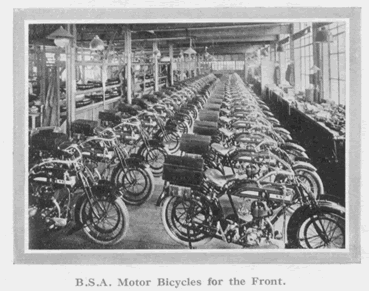 In
addition to the large quantities of Service Rifles required for the New
Army, there has been a constant demand for B.S.A. Bicycles and Motor Bicycles,
huge numbers of these being supplied both to the British and Allied Governments.
A special type of Military Bicycle which can be folded and carried on the
back when necessary has also been supplied. On almost every Front B.S.A.
machines are to be found, and have won great appreciation for their reliability.
In
addition to the large quantities of Service Rifles required for the New
Army, there has been a constant demand for B.S.A. Bicycles and Motor Bicycles,
huge numbers of these being supplied both to the British and Allied Governments.
A special type of Military Bicycle which can be folded and carried on the
back when necessary has also been supplied. On almost every Front B.S.A.
machines are to be found, and have won great appreciation for their reliability.
During the war the employees in the B.S.A. Factories achieved what was undoubtedly
a record in workers' war investments. Up to the first few days of 1918 no
less a sum than £250,000 had been subscribed to the various War Loans.
The visit of the Tank Bank to Birmingham was the occasion for a great demonstration,
and B.S.A. workpeople, during its one-week stay, gave a remarkable lead
to patriotic investors by purchasing 140,000 War Savings Certificates at
a total cost of over £ 100,000.
WELFARE WORK AMONG B.S.A.
EMPLOYEES.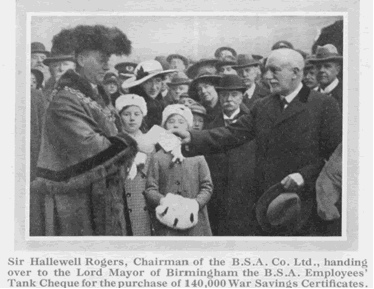
Throughout these strenuous times constant attention has
been devoted to the many problems affecting the health and well-being of
the thousands of people working in the B.S.A. Factories. The high pressure
at which production was maintained, and the employment of large numbers
of women who had magnificently responded to the appeals for volunteers for
National Service, made welfare work a subject of the greatest importance.
For these reasons commodious surgeries were built, and provided with the
finest equipment which modern science could devise. The surgeries are under
the control of a fully qualified staff, and employees receive free treatment
in cases of injury or sickness. The valuable work being carried out is shown
by the fact that in one B.S.A. Surgery alone over 50,000 cases are dealt
with annually. 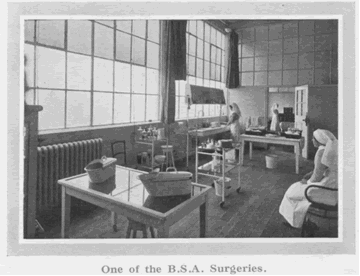 These
are principally of a minor character, and by thus dealing with these cases
at an early stage much suffering and loss are undoubtedly prevented. Rest
rooms are also provided, where employees temporarily indisposed may rest,
away from the hum and noise of machinery.
These
are principally of a minor character, and by thus dealing with these cases
at an early stage much suffering and loss are undoubtedly prevented. Rest
rooms are also provided, where employees temporarily indisposed may rest,
away from the hum and noise of machinery.
Another section of the welfare scheme is that devoted to improving the life and training of the boy workers. The physical development of the lads is encouraged by the teaching of Swedish Drill and Gymnastics. A large and well fitted Gymnasium is provided for this purpose, and the keen delight of the boys attending the classes is evidence of their appreciation of the efforts made to improve their conditions.
Classes are also held in the B.S.A. Works during factory
hours, for the purpose of training the boys' mental faculties, and assisting
them to attain a higher proficiency in the particular vocation each one
intends to follow.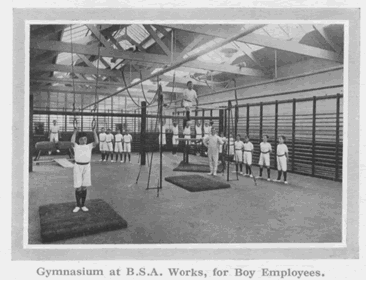
Commencing with instruction in general subjects, for the younger boys, the
course is carefully graduated as they progress, until the tuition becomes
of a more highly technical character. Apropos of the subject of training
the younger generation, it may be mentioned that for many years the "O"
Company of the 6th Royal Warwickshire Territorial Regiment was recruited
from B.S.A.
employees ; this company achieved a number of records for rifle shooting.
Upon the outbreak of war it proceeded on Active Service, and honourably
acquitted itself throughout the campaign. Shortly after the departure of
the B.S.A. Territorials for the Front a cadet corps was formed amongst the
B.S.A. boy employees,
and soon attained considerable strength and a high standard of smartness.
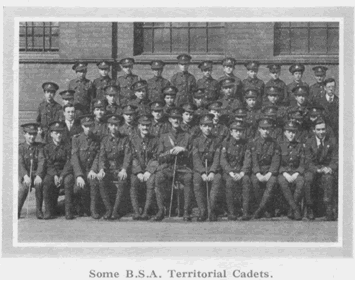
Every effort is thus being made to educate the boys in healthful habits, and to assist them in becoming useful citizens.
From the early days of the B.S.A., when Birmingham gun-makers co-operated
to give their services to their Country
in its hour of need, the products of the Company have steadily grown in
popularity. However keen the competition, one high standard of quality is
rigidly maintained, and on this policy is based the long record of success
comprised in B.S.A. History.
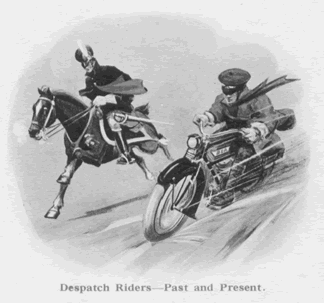
Return to the BIRMINGHAM SMALL ARMS Co. HISTORY MAIN PAGE
See this website's Raison d'être